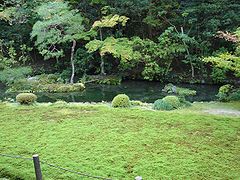

Hojo Garden / Nanzen-ji
The Hojo Garden at Nanzen-ji Temple is one of Kyoto's most representative karesansui (dry landscape) gardens and is designated as an Important Cultural Property. Created during the late Muromachi to early Edo periods, this garden surrounds the "Hojo," the residence of the temple's abbot. The garden employs stones and sand to symbolically represent mountains and water, characteristic of the karesansui style. It is particularly famous for the rock formation known as "Tiger Cub Crossing." Additionally, there is a rock arrangement that imitates a waterfall called "Ryūmonbaku," symbolizing a dragon legend from Chinese classical literature. The garden exudes tranquility and embodies the spirit of Zen, attracting many visitors with its beauty and serene atmosphere.